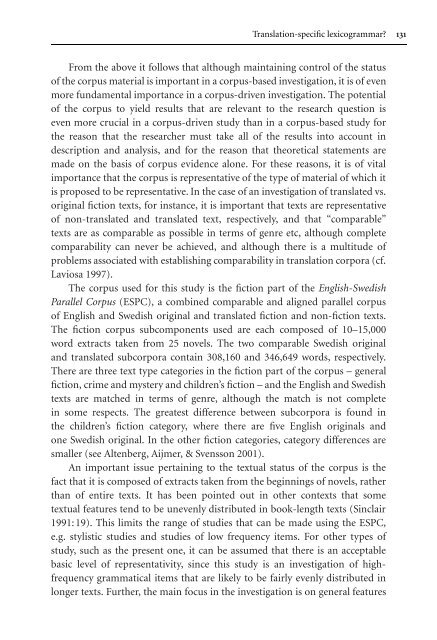Translation Universals.pdf - ymerleksi - home
Translation Universals.pdf - ymerleksi - home
Translation Universals.pdf - ymerleksi - home
Create successful ePaper yourself
Turn your PDF publications into a flip-book with our unique Google optimized e-Paper software.
<strong>Translation</strong>-specific lexicogrammar? 131<br />
From the above it follows that although maintaining control of the status<br />
of the corpus material is important in a corpus-based investigation, it is of even<br />
more fundamental importance in a corpus-driven investigation. The potential<br />
of the corpus to yield results that are relevant to the research question is<br />
even more crucial in a corpus-driven study than in a corpus-based study for<br />
the reason that the researcher must take all of the results into account in<br />
description and analysis, and for the reason that theoretical statements are<br />
made on the basis of corpus evidence alone. For these reasons, it is of vital<br />
importance that the corpus is representative of the type of material of which it<br />
is proposed to be representative. In the case of an investigation of translated vs.<br />
original fiction texts, for instance, it is important that texts are representative<br />
of non-translated and translated text, respectively, and that “comparable”<br />
texts are as comparable as possible in terms of genre etc, although complete<br />
comparability can never be achieved, and although there is a multitude of<br />
problems associated with establishing comparability in translation corpora (cf.<br />
Laviosa 1997).<br />
The corpus used for this study is the fiction part of the English-Swedish<br />
Parallel Corpus (ESPC), a combined comparable and aligned parallel corpus<br />
of English and Swedish original and translated fiction and non-fiction texts.<br />
The fiction corpus subcomponents used are each composed of 10–15,000<br />
word extracts taken from 25 novels. The two comparable Swedish original<br />
and translated subcorpora contain 308,160 and 346,649 words, respectively.<br />
There are three text type categories in the fiction part of the corpus – general<br />
fiction, crime and mystery and children’s fiction – and the English and Swedish<br />
texts are matched in terms of genre, although the match is not complete<br />
in some respects. The greatest difference between subcorpora is found in<br />
the children’s fiction category, where there are five English originals and<br />
one Swedish original. In the other fiction categories, category differences are<br />
smaller (see Altenberg, Aijmer, & Svensson 2001).<br />
An important issue pertaining to the textual status of the corpus is the<br />
fact that it is composed of extracts taken from the beginnings of novels, rather<br />
than of entire texts. It has been pointed out in other contexts that some<br />
textual features tend to be unevenly distributed in book-length texts (Sinclair<br />
1991:19). This limits the range of studies that can be made using the ESPC,<br />
e.g. stylistic studies and studies of low frequency items. For other types of<br />
study, such as the present one, it can be assumed that there is an acceptable<br />
basic level of representativity, since this study is an investigation of highfrequency<br />
grammatical items that are likely to be fairly evenly distributed in<br />
longer texts. Further, the main focus in the investigation is on general features
















